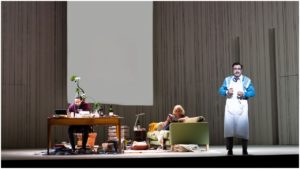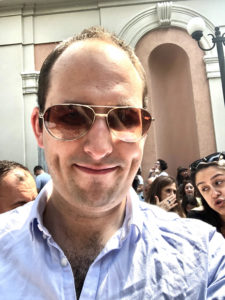
Glyndebourne Festival 2021 Review: ‘Il turco in Italia’
A sparkling vision of Rossini’s farce is a delight throughout
By Benjamin PooreRossini’s operatic world is a crossroads of things: the formal conventions of arias, duets, cavatina, patter number, the stock characters of the Commedia dell’arte, a hotchpotch of contemporary patriarchal and orientalist stereotypes, and reheated scenarios from various librettists. How do modern audiences, relatively unmoored from this world, connect with these shows?
A Brilliant Production
In this new production of “Il turco in Italia,” Mariame Clément makes it a story about storytelling, overlaying a totally original supplementary story created by Lucy Wadham. Poet Prosdocimo is a famous novelist, who is signing copies of his book “Motherland,” before beginning work, years later, on his comedy, to be titled “The Turk.” The other characters emanate from his creative consciousness, where he tries on different styles and moods, his thoughts projected on a big notepad that sits upstage. “19th Century (“not sexy”), he muses, before moving the action into the 1950s (“neorealism”), in a delicatessen that could be straight out of Fellini, designed beautifully and colorfully by Julia Hansen.
This means a dizzying and witty mix of costumes and props, and full credit should go to the backstage team who worked seamlessly. The story is as silly as anything in Rossini. The visiting Turk Selim is caught between the affections of gypsy Zaida and married woman Fiorillo, while husband Geronio seethes; Don Narciso the substantive tenor role has his own designs on Fiorilla. These crossed desires are rather helpfully diagrammed out by Prosdocimo as it goes on. After a feint from Geronio in the final act, where he seems to threaten Fiorilla with disgrace, all is made up and Selim returns to Istanbul along with Zaida.
The characters begin to take charge in the Act one finale, threatening to beat up the Poet and tearing up his drafts. This is more than mere postmodernist chicanery, like something out of Borges or Calvino. “Il turco in Italia” is a composite of multiple ideas and versions, some in conflict – Felice Romani reworked an existing libretto by Caterino Mazzola which had already been set by Franz Seydelmann; Rossini tussled with singers about inserting showstopper arias and farmed out bits of the recitative to his assistants. The creative process in opera is always going to be a bit of a battle, and Clement’s scenario hints at this deftly.
It is not an opera of arias, especially, favoring great trios and duets, and most notable the glorious Act two quintet. Musically, it is full of borrowing – Fiorilla’s great aria is symphonically expansive, like something from the grand opera to come; Selim’s opening number alludes to Rossini’s own “Tancredi”. It’s a deeply knowing opera. A quotation from “Don Giovanni” in Act one reminds us that Rossini is interested in exploring questions of sexual morality and freedom – further references to the work pile up in the second half, with subterfuge at a masked ball, two basses threatening to stab each other, and the Poet’s teasing reflections of the moral of the story should be.
Clément’s production though never a seminar, touches on questions important to directors, singers, and audiences alike. ‘Could Don Giovanni be written today?’ the Poet scribbles on his notepad in Act one. The operatic canon is full of stories about women and minorities told by white men, and how we explore the balance of expressive power in the opera world today, and in its canon, is a critical question. Of course “Il turco in Italia” is the perfect vehicle for this, featuring as it does – on the surface at least – some of the flattest gender and ethnic stereotyping in opera. Clément’s reflexive approach to the text allows us to see them for what they are, and understand them in the context of this production as emanations of the limited imaginative horizons of a writer of pulp fiction.
Poet’s unnamed Girlfriend who acted silently with deft expressiveness by Anne-Marie Sullivan challenges his clichè approach to writing women; putting her own stamp on the story, and sometimes interceding in its action. One thing the show does is to brilliantly send up tired aesthetics and gestures that are hardly unknown to opera audiences: “Gypsies: counter-cultural”, the Poet muses; “Fiorilla: unfaithful liberated”.
At the climax of the show, the moment of the blackout, it is the Girlfriend who sits at the laptop ready to write. There is nothing didactic here, but Clement makes it clear powerfully that opera must bequeath its expressive resources to a new world.
Bel Canto At Its Finest
Sesto Quatrini conducted the players of the LPO with a champagne-like effervescence, fizzing with comic potential from the taught opening triples and dotted rhythms of the overture, an introduction remarkable for an outstanding horn solo. Tempi were quick – another sign of the times, where producers and musicians are keen to minimize our exposure indoors to each other – but sprightly rather than hurried. Scenes segued seamlessly into one another, with the piano of Sergey Rybin picking up elegantly where Quatrini left off.
Nahuel Di Pierro’s Selim swaggers through the role with some floor-creaking bottom notes. Alessio Arduini’s Prosdocimo is onstage for the entirety of Act one and acts convincingly throughout; vocally he boasts dark colors throughout the register and no fear of anything above the stave. Michele Angelini’s Don Narciso only has a slight role, ultimately, but his Act two aria was blisteringly virtuosic, with quicksilver passagework and a compelling sense of line.
Rodion Pogossov’s patter arias as Don Geronio could scarcely have been bettered; indeed the whole cast impressed in the machine-gun masked ball number, ‘Questo vecchio maledetto’. Elena Tsallagova as Fiorilla dazzled throughout, with impeccable lightness in her coloratura and delicately deployed colors all across the voice. The Glyndebourne chorus, led by Aiden Oliver, was precise and well-balanced, even when distanced and somewhat reduced. This is a brilliantly inventive production that should prove a highlight of the festival; more tickets may be released if restrictions are lifted in late June – get them while you can.



